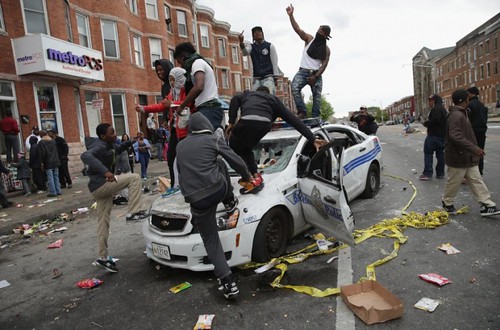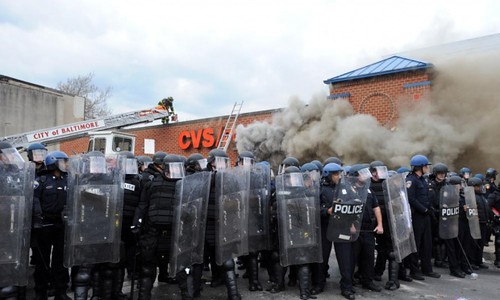Baltimore: riots, the coercive power of the state, and public reaction
Washington Post graphic showing locations of rioting in Baltimore yesterday and last night.
In 2008, on the occasion of the MLK Holiday, I wrote this:
I have been meaning to write about the Barack Obama-Hillary Clinton debacle over "it takes a president, not a village, to get things done."As I have written before in terms of the writing by John Friedmann in terms of creating radical planning discourse, government is oriented to system maintenance and a wee bit of change and innovation.
The reality is that change is a process.
Transformation efforts, and the Civil Rights Movement was the biggest social and political transformation effort/movement in U.S. society in the past 60+ years, start from outside government, with the people. (Revolutionary movements challenge governments and the entire political system.)
Sure, laws are only changed by elected officials, but it takes thousands, millions of individual efforts before the point of legislative and/or executive branch change within government is reached, and eventually (if ever) realized.Riots are expressions of anger and feelings of abandonment and hopelessness.
And expressions of anger are typical when citizens are increasingly disconnected from those institutions that are supposed to be representing and hearing from them.

Demonstrators took over the streets. Photograph: Chip Somodevilla/Getty Images.
But while riots can push change forward--for example the Department of Justice review of the system of criminal justice and policing in response to the public outcry over the death of Michael Brown in Ferguson, Missouri led to a number of top level resignations of key officials including the police chief and city manager--in terms of "place effects," riots are hyper destructive and make urban improvement that much harder, if not impossible.
For example, on H Street NE in Washington, DC, it has taken between 40 and 45 years for the commercial district to show serious signs of recovery since the 1968 riots, which on H Street and elsewhere destroyed most of the city's independent retail businesses--which is why the state of independent retail in the city is still comparatively underdeveloped.

Looting and rioting broke out at North and Pennsylvania Avenues where a CVS was set on fire. Photograph: TNS/Landov / Barcroft Media.
But H Street NE in Washington DC is now part of a one of the strongest real estate markets in the US, while Baltimore and comparable cities still lag. Most areas in Detroit affected by the 1967 riots have never recovered. In fact, Pennsylvania Avenue in Baltimore has never recovered from the twin blows of the 1968 riots there, and the post-riot urban renewal process.
And often, groups can be incited to riot by people who for whatever reason, want violence to occur.
Once the spark is lit, the track of the outburst is unpredictable and unmanageable.
On the other hand, the power to use coercion and force on the behalf of the state comes with great responsibility. Clearly, the Baltimore City police officers whose actions led to the death of Freddie Gray failed to acknowledge their responsibilities to citizens.

Drew Angerer, Getty Images. Baltimore police officers walk in formation on Reisterstown Road near Mowdamin Mall as they advance toward protesters on April 27, 2015.
Baltimore's situation also gives me some perspective on one of the reasons that DC has more local police officers per capita than any other US city. This doesn't even take into account the federal and other police departments that operate within DC.
DC has twice the number of local police officers than Baltimore. But Baltimore has more poverty and is somewhat larger.
Labels: change-innovation-transformation, participatory democracy and empowered participation, policing, poverty, protest and advocacy, riots and unrest




8 Comments:
1. The more I look into the story the less sense it makes. I thought the police beat the crap out of him in the van as they used to do. Now they say it was because of rough riding. Not sure about that. I think he was injured in the encounter and not treated.
2. The police are deliberately standing down and letting everyone remind them why they are there.
3. Riots are about not about anger. They are about showing who is boss. You'll notice they mostly target minorities (i.e. arab shopkeepers, nigerians, koreans).
two things I would like to see come out of all of this craziness; non lethal take down technology- IOW- anasthetic darts- they already exist - it is just cultural and experiential lassitude keeping police forces from using them. These would enable less brutal shot to kill and could allow cops to put an end to mass demonstrations turned violent very quickly. There is absolutely no reason that is rational in the world NOT to do this as soon as possible. It would lessen the stakes and rachet down the tension. The other item- our country as a whole needs to radically revisit the grand jury system- which is not only obsolete and dysfunctional- it is a huge burden on regular working class people who are required to particpate in it. The way it functions is absurd and often unfair. I was totally disgusted by the way it was done when I had to serve on the DC grand jury back in 2006. Sadly- the lawyers who control everything in the USA will not allow ANY changes at all to this sick and backwards deplorable setup. The founding fathers are turning over in their graves now.
the post riot renewal process you mentioned is important- this "process" can be just as damaging if not more than the riots themselves. Urban renewal has a very clouded and abysmal history in this country
apparently the first new post-riot building on H St. NE was not constructed until 1974, six years after the riots.
2. The H St. Urban Renewal plan was developed and frankly, probably was the most realized of all the plans in the city. Everything was pretty much built out as planned by about 1990.
But the corridor still languished. All those projects didn't make a difference. In large part, they were misguided, and were more about changing the type of buildings (the office buildings, strip shopping center, crappy but brick rowhouses, Hechinger Mall, etc.) from what had been there, and didn't value the place qualities already present in the area.
In the end, those place qualities + transit + selective infill were the elements that triggered improvement.
I know that on Pennsylvania Ave. in Baltimore, most of the old cool buildings like theaters etc. were "renewed" via demolition. So authentic place qualities there are long gone.
charlie -- hmm. I think riots are complicated, a bunch of things. But showing who is boss--without ultimately being revolutionary--is likely a big element.
wrt "the event," yep, it sounds weird. Likely your surmise about what happened is correct. Police tend to think people are "shamming" (the word used in the movie "Biko") but sometimes and not infrequently, they aren't making stuff up, to the chagrin and ultimate downfall of the police.
Hm-m-m. Take a look at these HuffPo maps from yesterday:
http://www.huffingtonpost.com/2015/04/28/baltimore-segregated-maps-riots_n_7163248.html
Riots/"civil unrest" are symptoms. Reacting to and treating symptoms alone is a distraction from dealing with the underlying issues.
-EE
oh yes. I've spent some time in Baltimore in some of those "bad places." I read the Balt. Sun pretty regularly for most of the 1990s and 2000s. When I worked in Towson, I went up and down York/Greenmount a lot, and had some bus rides to get to meetings that took me through West Baltimore. I tell you, I felt very uncomfortable in some of those places.
Much thanks to you for giving such significant data, and a debt of gratitude is for sharing this Business Promotion system.
Post a Comment
<< Home